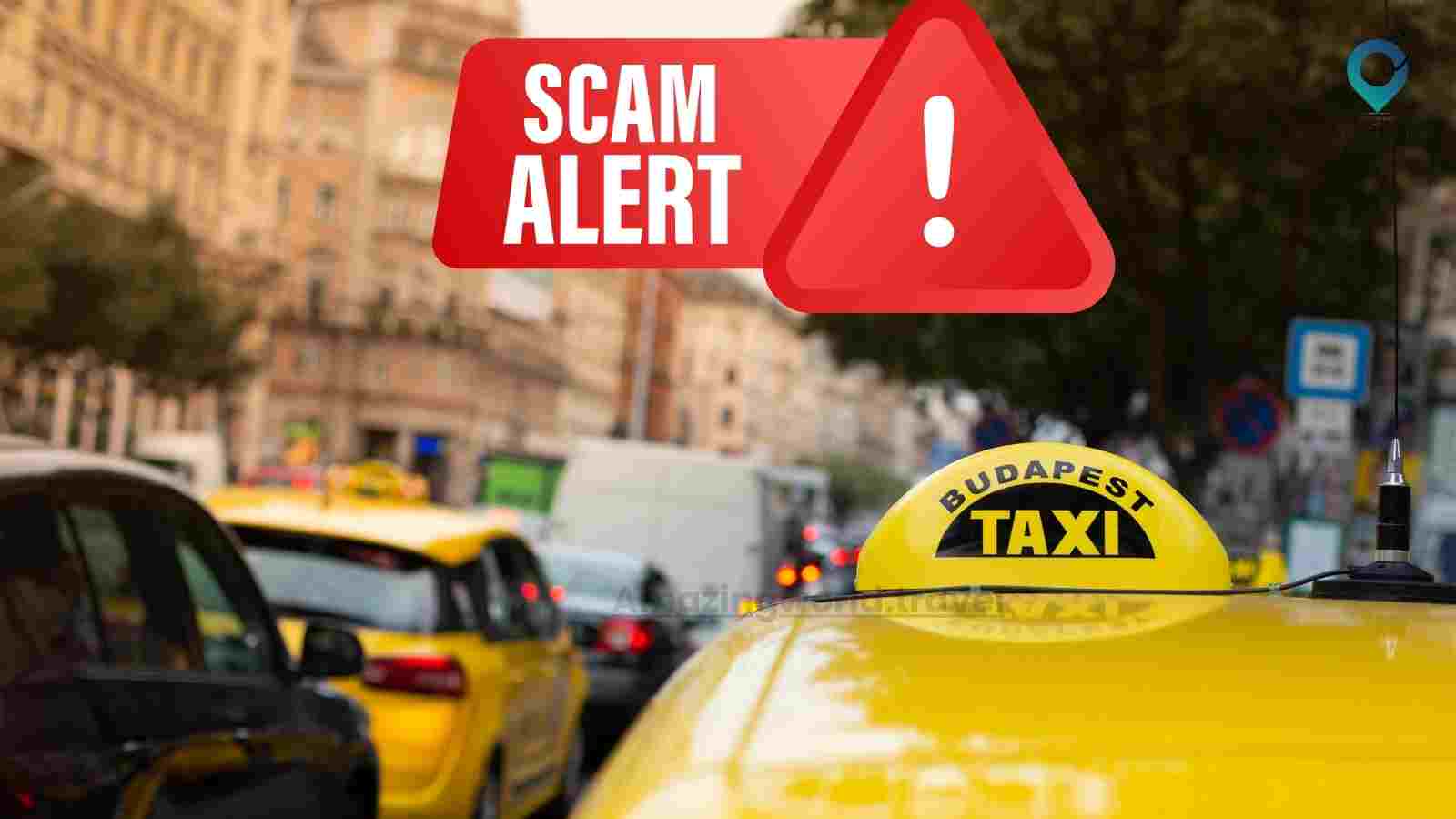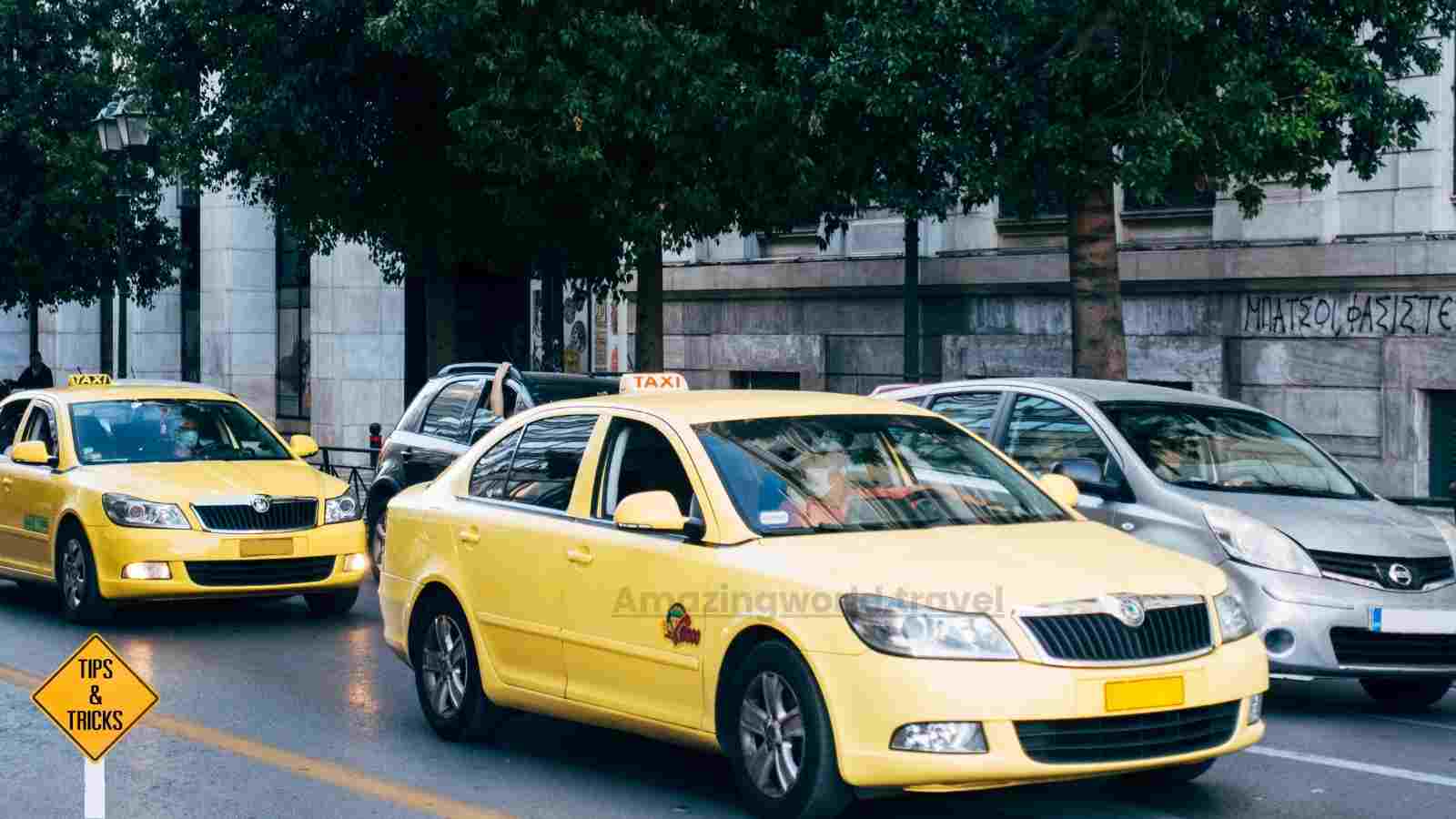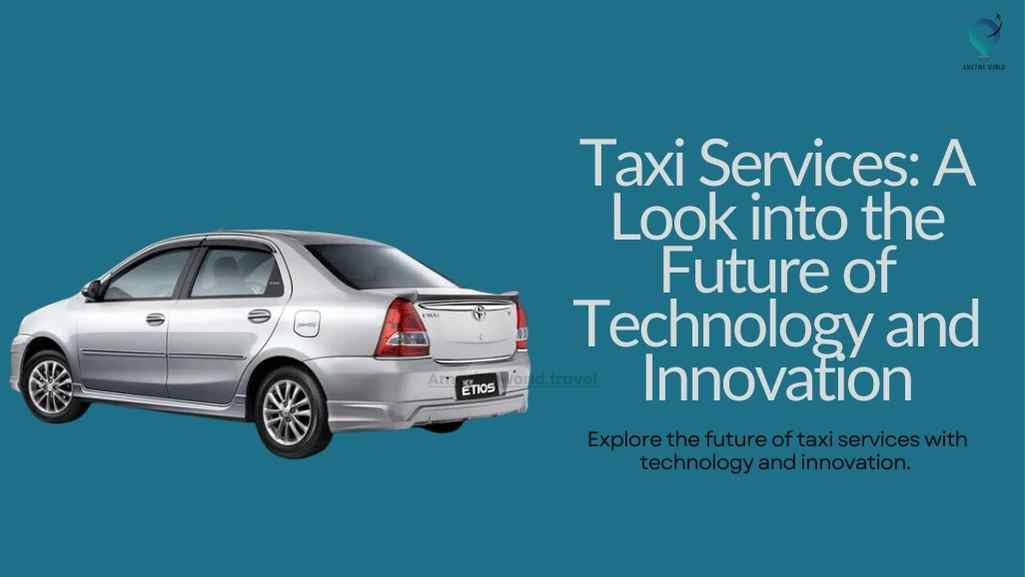10 Common Travel Scams and How You Can Avoid Them
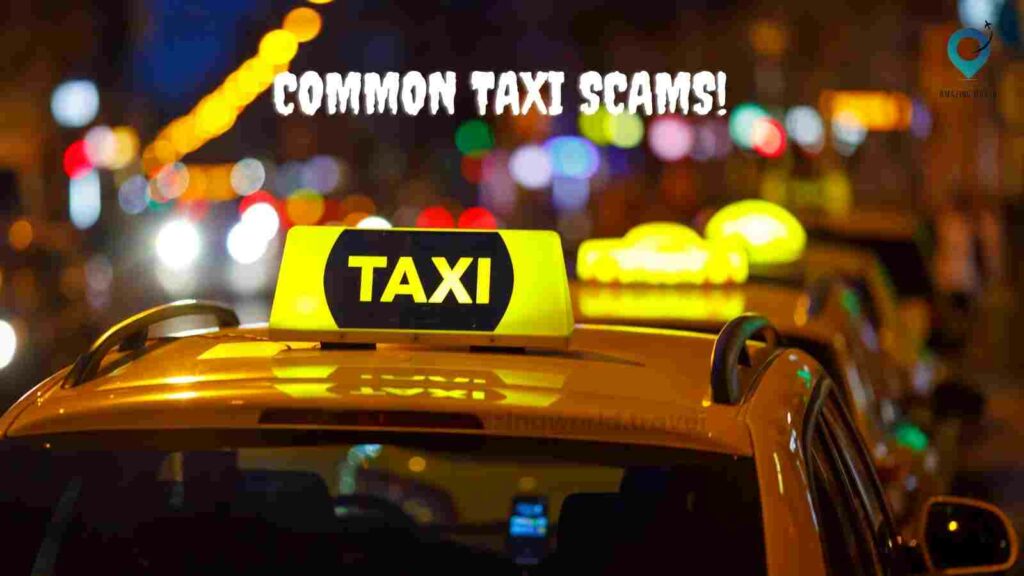
Are you a savvy traveler seeking to explore new destinations without falling prey to cunning taxi scams? As you embark on your adventures, it’s essential to be armed with knowledge that will safeguard your wallet and peace of mind. In this comprehensive guide, we will unveil the top 10 common taxi scams, providing you with the insights and strategies you need to outsmart these deceitful tactics and enjoy your journey without any worries.
Whether you’re hailing a cab from the airport or navigating bustling city streets, our focus keywords – “taxi scams” and “traveler’s safety” – will be your guiding lights. Let’s delve into the world of travel with confidence, leaving taxi scams far behind!
Looking for the best Car Rental service for your next travel Jouney? Therefore, we recommend you book your car rental from DiscoverCars.com – Official Website
Common Taxi Scams
Scam #1: Fake Taxi Meters
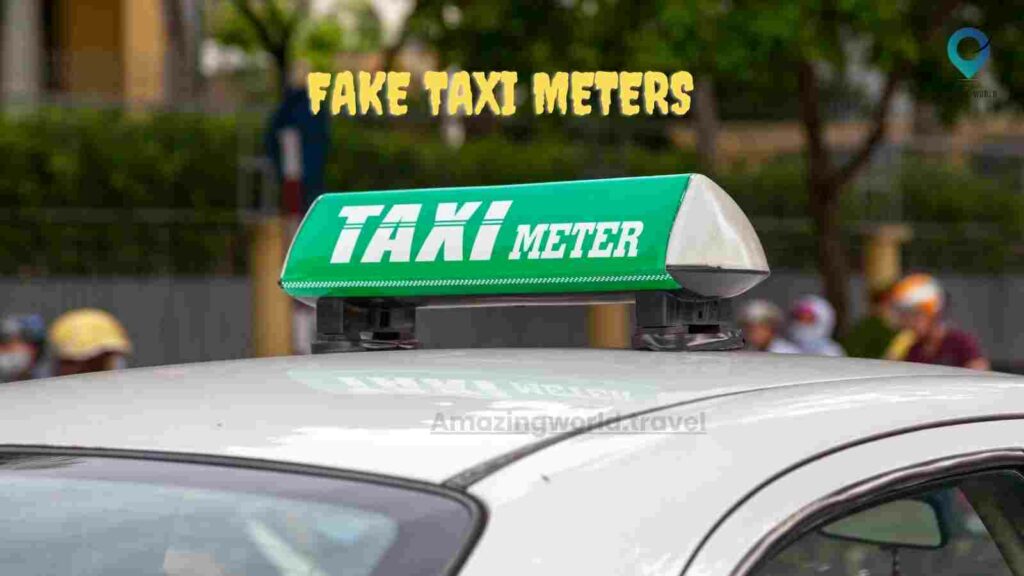
Explanation of How Fake Taxi Meters Work
Fake taxi meters are a deceptive tactic employed by unscrupulous taxi drivers to overcharge unsuspecting passengers. These meters are rigged to calculate fares at a significantly faster rate than the actual distance traveled or time spent on the ride. Here’s how they typically work:
- Manipulated Meter Settings: Dishonest taxi drivers may tamper with the internal settings of their meters, making them run faster than normal. This means that even if your journey is a short one, the meter will display a higher fare as if you had traveled a longer distance.
- Hidden Buttons or Switches: In some cases, drivers may have hidden buttons or switches in the taxi that they can use to activate the fake meter. They might do this discreetly during the ride, so passengers are unaware of the manipulation.
- Incorrect Fare Calculation: The meter calculates fares based on both distance and time. Fake meters can inaccurately record both parameters, making it challenging for passengers to gauge whether the fare is reasonable.
How to Recognize and Avoid Them
Recognizing and avoiding fake taxi meters is crucial to prevent being overcharged. Here are some steps to help you identify and steer clear of this scam:
- Check the Meter at the Start: When you enter the taxi, take a moment to observe the meter as it starts. If it jumps to an unusually high amount or shows signs of rapid acceleration, it could be a red flag.
- Ask for a Fare Estimate: Before you start the ride, inquire about the approximate fare to your destination. This will give you a rough idea of what to expect and help you spot any discrepancies later.
- Use a Navigation App: GPS-based navigation apps like Google Maps or local equivalents can give you a reasonable estimate of the distance and time it should take to reach your destination. Compare this with the meter’s reading.
- Report Suspected Scams: If you suspect that the meter is rigged or you’re being overcharged, take a picture or note the taxi’s license number. You can report such incidents to local authorities or taxi regulators.
- Choose Reputable Taxi Companies: Opt for well-known and reputable taxi companies, as they are more likely to have stringent maintenance and inspection standards for their meters.
- Negotiate Fares in Advance: In some locations, it’s common to negotiate the fare before starting the ride. This can help you avoid meter-related scams altogether.
Being vigilant and informed can help you avoid falling victim to fake taxi meters and ensure that you pay a fair and accurate fare for your taxi ride. Remember that not all taxi drivers engage in such practices, but it’s essential to be prepared for the possibility when traveling in unfamiliar areas.
Scam #2: Long Routes

How Drivers Take Longer Routes to Overcharge
Taking longer routes to overcharge passengers is a common taxi scam that dishonest drivers employ to increase the fare. Here’s how it typically works:
- Familiarity with the Area: Some drivers may have an intimate knowledge of their local area, allowing them to take less direct routes while appearing legitimate. They rely on passengers’ lack of familiarity with the area to go unnoticed.
- Unnecessary Detours: Drivers may intentionally take detours or alternate routes that are longer than the most direct path to your destination. This can significantly increase the distance traveled and, consequently, the fare.
- Avoiding Traffic: In some cases, drivers may claim to be avoiding heavy traffic or road closures, justifying the longer route. While this can be legitimate at times, it’s often used as an excuse to take an unnecessarily lengthy route.
Tips to Spot and Prevent This Scam
- Travel with Local Advice: If possible, seek advice from locals or your hotel concierge about the best routes to your destination. Their insights can help you make informed decisions about the route the taxi driver should take.
- Use Reputable Taxi Companies: Opt for established and well-known taxi companies, as they often have stricter guidelines and training for their drivers. These companies are more likely to prioritize customer satisfaction and safety.
- Trust Your Instincts: Sometimes, your gut feeling can be a valuable indicator. If you have a strong sense that the route being taken is unnecessarily long, it’s worth questioning the driver or even requesting a different route.
- Maintain an Assertive Yet Polite Approach: If you suspect the driver is intentionally taking a longer route, address the issue calmly and assertively. Politely express your concern and request that they take the shortest path to your destination.
- Take a Photo or Note the License Plate: Consider taking a photo of the taxi’s license plate before starting the ride. This can be helpful in case you need to report any suspicious activity.
- Educate Yourself About Fare Regulations: Some cities have strict regulations governing taxi fares, including fixed rates for common routes. Familiarize yourself with these regulations, and if you suspect you’re being overcharged due to an unnecessarily long route, bring it up with the driver.
- Leave a Review: After your ride, consider leaving a review on a rideshare or taxi app to share your experience with others. This can help fellow travelers avoid dishonest drivers.
- Report Any Concerns: If you believe you’ve been a victim of the long route taxi scam, report your experience to local authorities or the appropriate regulatory body. Your report can contribute to efforts to curb such practices.
By following these tips and staying informed, you can significantly reduce the chances of falling victim to the long-route taxi scam. While most taxi drivers are honest and professional, it’s essential to be prepared to encounter scams, especially when traveling to new or unfamiliar destinations. Your proactive approach can help ensure a fair and pleasant taxi experience during your travels.
Scam #3: Overcharging

Explanation of Excessive Fares and Price Negotiations
Overcharging in the context of taxi scams involves drivers charging fares that are significantly higher than the actual cost of the ride. It can occur for various reasons, such as taking advantage of tourists or exploiting unfamiliarity with local fares. Here’s how it typically unfolds:
- Unregulated Pricing: In some places, taxi fare regulation may be lax or nonexistent, allowing drivers to set their rates. This lack of standardization can lead to overcharging, especially for passengers who are unaware of typical fare ranges.
- Taking Advantage of Tourists: Taxi drivers often target tourists who may not be familiar with local fare structures. They may quote inflated prices, counting on the fact that tourists are less likely to challenge the fares.
- Exploiting Rush Hour or Special Events: During peak traffic hours or special events, some drivers may take advantage of high demand by charging elevated fares. They might use the excuse of heavy traffic to justify the increased price.
Strategies to Avoid Being Overcharged
Avoiding overcharging requires a combination of awareness, negotiation skills, and preparedness. Here are some strategies to help you avoid falling victim to this scam:
- Research Fares in Advance: Before your trip, research typical taxi fares in the area you’ll be visiting. Online travel forums, apps, or even asking locals can provide insights into what you should expect to pay.
- Agree on the Fare Before the Ride: Whenever possible, negotiate and agree on the fare with the driver before starting the journey. This sets clear expectations and reduces the likelihood of surprises at the end of the ride.
- Ask Locals for Advice: If you’re unsure about fare ranges, ask locals or your hotel staff for guidance. They can give you a ballpark figure to use as a reference.
- Use Ride-Share or Taxi Apps: Consider using ride-share or taxi apps that provide transparent pricing and payment options. These apps often calculate fares based on distance and time, reducing the risk of overcharging.
- Monitor the Meter: If the taxi has a meter, ensure it is running from the moment the ride starts. Keep an eye on it to ensure it is recording the fare accurately.
- Question Inflated Prices: If the driver quotes a fare that seems unreasonably high, don’t hesitate to question it. Politely ask for an explanation or request that they use the meter or provide a more reasonable rate.
- Carry Small Denominations: Having small bills or coins on hand can be beneficial. It allows you to pay the exact fare, reducing the risk of the driver claiming not to have change and overcharging you.
- Know the Distance: Familiarize yourself with the approximate distance to your destination. If the fare seems excessive for the distance traveled, question it.
- Trust Your Instincts: If something doesn’t feel right about the fare or the driver’s behavior, trust your instincts. You have the right to prioritize your safety and financial well-being.
- Leave Feedback: After the ride, consider providing feedback through ride-share or taxi apps, as it can help hold drivers accountable and assist future passengers.
By employing these strategies and staying informed, you can minimize the risk of being overcharged by taxi drivers and ensure a fair and hassle-free transportation experience during your travels. Being proactive and assertive, when necessary, can go a long way in avoiding overcharging scams.
Scam #4: Counterfeit Currency
How Drivers Exchange Counterfeit Money
Counterfeit currency scams involving taxi drivers can take various forms, but they typically involve drivers providing passengers with counterfeit money as change or payment for their services. Here’s how they may exchange counterfeit currency:
- Switching Genuine Bills: Some dishonest drivers may hand over counterfeit money as part of your change while discreetly keeping genuine bills for themselves. This can be difficult to detect, especially in low-light conditions or when you’re in a hurry to leave the taxi.
- Receiving Counterfeit Payments: In some cases, drivers may intentionally accept counterfeit money from passengers, knowing that it’s fake. They might then pass this counterfeit currency to other unsuspecting passengers as change or as payment for their services.
- Collaboration with Others: In more elaborate scams, taxi drivers might collaborate with others who provide them with counterfeit currency. These accomplices might pose as passengers or even as legitimate service providers, making it challenging for passengers to trace the source of the counterfeit money.
Ways to Verify Currency Authenticity
To protect yourself from receiving counterfeit currency while using taxis, here are some practical ways to verify the authenticity of the money you receive:
- Use a Counterfeit Detector Pen: Invest in a counterfeit detector pen, which can be a handy tool to quickly check the authenticity of bills. These pens can detect counterfeit money by revealing a dark mark on fake bills.
- Familiarize Yourself with Genuine Bills: Spend some time familiarizing yourself with the appearance and security features of genuine currency for the country you’re in. Look for watermarks, security threads, and holograms, if applicable.
- Inspect Bills Carefully: Take a close look at any bills you receive from the driver. Check for any irregularities in printing, color, or texture. Pay attention to the feel of the paper; counterfeit money often feels different from genuine currency.
- Use Ultraviolet (UV) Light: UV lights can reveal hidden security features on many modern banknotes. Carry a small UV flashlight and shine it on the money you receive to check for UV-responsive elements.
- Ask for Smaller Denominations: If possible, ask for smaller denominations when breaking larger bills. Counterfeiters often focus on producing higher-value denominations, making smaller bills less susceptible to forgery.
- Count Your Change: Always count the change you receive before leaving the taxi. Ensure that the total matches your fare and that all the bills are genuine.
- Trust Your Instincts: If you have any doubts about the authenticity of the currency you receive, don’t hesitate to ask the driver for different bills or payment methods.
- Report Suspected Counterfeit Money: If you believe you’ve received counterfeit currency, report it to the local authorities. They can provide guidance on how to proceed.
Remember that counterfeit currency is a concern in many parts of the world, and taxi drivers are not the only individuals who may attempt to pass off fake bills. Being vigilant and knowledgeable about currency authentication methods is essential to protect yourself from falling victim to this type of scam.
Scam #5: Broken Meters

How Drivers Claim Their Meters Are Broken
The “broken meter” scam is a tactic where taxi drivers claim that their meters are out of order or malfunctioning, allowing them to charge passengers arbitrary, inflated fares. Here’s how drivers may go about this:
- False Display: Some drivers might intentionally tamper with their meters to display error messages or unusual readings, giving the impression that the meter is genuinely broken.
- Unplugging or Disconnecting: Drivers may secretly unplug or disconnect the meter before the ride begins, rendering it nonfunctional. Passengers may not notice until the end of the journey.
- Accidental Malfunctions: In some cases, the meter may genuinely malfunction due to technical issues. However, dishonest drivers may exaggerate the problem or use it as an excuse to overcharge passengers.
How to Respond When Faced with This Scam
Dealing with a taxi driver who claims to have a broken meter requires a calm and assertive approach. Here’s how to respond when faced with this scam:
- Stay Calm: Keep your composure and avoid getting into an argument with the driver. Maintaining a calm demeanor will help you handle the situation more effectively.
- Request to Start the Meter: Politely ask the driver to restart the meter or fix the issue. Sometimes, the driver may quickly “fix” the problem when confronted.
- Agree on a Fare in Advance: If the driver insists that the meter is indeed broken and cannot be repaired during the ride, negotiate and agree on a flat fare before continuing the journey. Ensure that the negotiated fare is reasonable based on your destination and local rates.
- Use a Ride-Share App: If you suspect the meter is genuinely broken, and negotiations don’t result in a reasonable fare, consider using a ride-share app or another taxi with a functioning meter.
- Document the Situation: If you believe the driver is attempting to scam you, take note of the driver’s information (name, license number, and taxi number) and any evidence of the broken meter, such as a photo. This information may be useful if you need to report the incident later.
- Report the Incident: Report the situation to local authorities or taxi regulators after your ride. They can investigate the driver and take appropriate action if the meter tampering is confirmed.
- Leave Feedback: If you’re using a ride-sharing or taxi app, provide feedback about your experience, including details about the broken meter, to help other passengers avoid similar issues.
Remember that while some meters may genuinely malfunction, it’s essential to be cautious and ensure that any fare you agree to pay is reasonable and fair for the distance traveled. Staying informed and prepared can help you handle the situation if you encounter a taxi with a claimed broken meter during your travels.
Scam #6: Fixed Prices
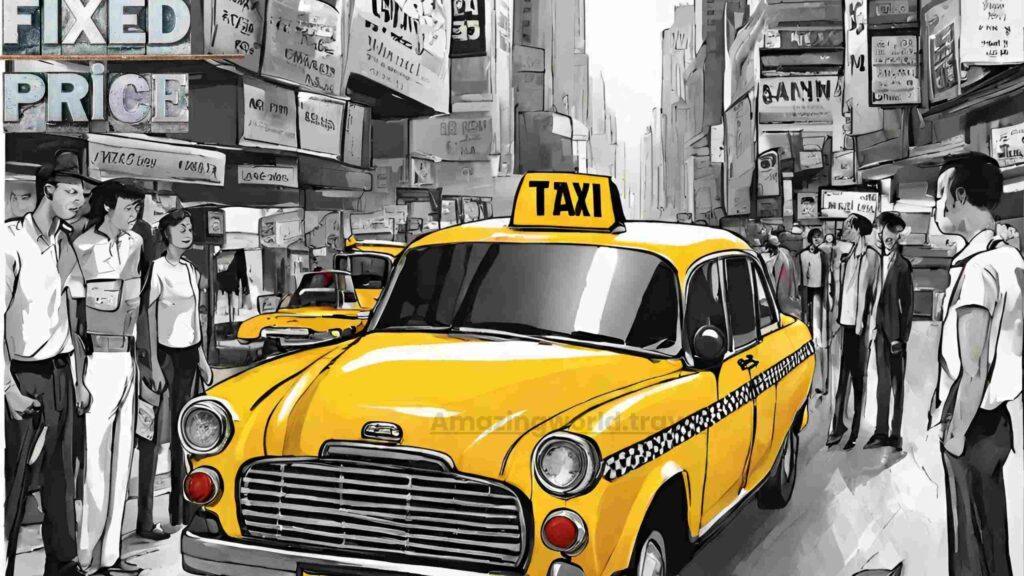
Explanation of Set Prices That Don’t Match the Meter
The “fixed price” scam involves taxi drivers quoting passengers a predetermined or fixed fare that doesn’t align with the metered rate. Here’s how this scam typically unfolds:
- Quoting a High Price: Some drivers may quote a significantly higher flat rate than what the meter would calculate based on the distance and time traveled. This inflated fixed price is intended to overcharge passengers.
- Claiming Meter Problems: In some instances, drivers may justify the fixed price by claiming that their meter is broken, inaccurate, or unreliable, even if it’s functioning correctly.
- Exploiting Unfamiliarity: Taxi drivers often target tourists or passengers who are unfamiliar with local fares, making it easier to convince them to accept the fixed rate.
How to Negotiate Fares and Avoid Fixed Prices
Negotiating fares and avoiding fixed prices requires assertiveness and knowledge of local taxi fare norms. Here’s how to handle this scam:
- Ask to Start the Meter: Always request that the driver start the meter at the beginning of the ride. Insist on this even if the driver suggests a fixed rate.
- Research Local Fare Standards: Before your trip, research the typical taxi fares in the area you’ll be visiting. Knowing the approximate cost of your journey can help you negotiate effectively.
- Question the Fixed Price: If the driver insists on a fixed price that seems unreasonably high, politely question it. Ask for a breakdown of how the fare is calculated, and compare it to what the meter would display.
- Negotiate a Fair Rate: If the fixed price offered by the driver is much higher than what the meter would indicate, negotiate for a more reasonable fare. Politely suggest a rate that aligns with your research.
- Consider Alternative Transportation: If the driver remains inflexible and insists on a fixed price that you find unacceptable, consider seeking alternative transportation options, such as ride-sharing services or other taxis.
- Document the Incident: If you encounter resistance or feel that you’re being scammed, document the driver’s information (name, license number, and taxi number) and any evidence of the situation, such as a photo or note.
- Report the Incident: After your ride, report the incident to local authorities or taxi regulators. They can investigate the driver’s actions and take appropriate measures if necessary.
- Use Reputable Taxi Companies: Opt for established and reputable taxi companies, as they are less likely to engage in fixed price scams and often adhere to standard fare rates.
By being informed about local taxi fare standards and standing your ground when faced with unreasonable fixed prices, you can protect yourself from falling victim to this scam. Remember that the meter is a reliable and transparent way to determine the fare for your taxi ride, and it should be used whenever possible to ensure fair pricing.
Scam #7: Unlicensed Taxis
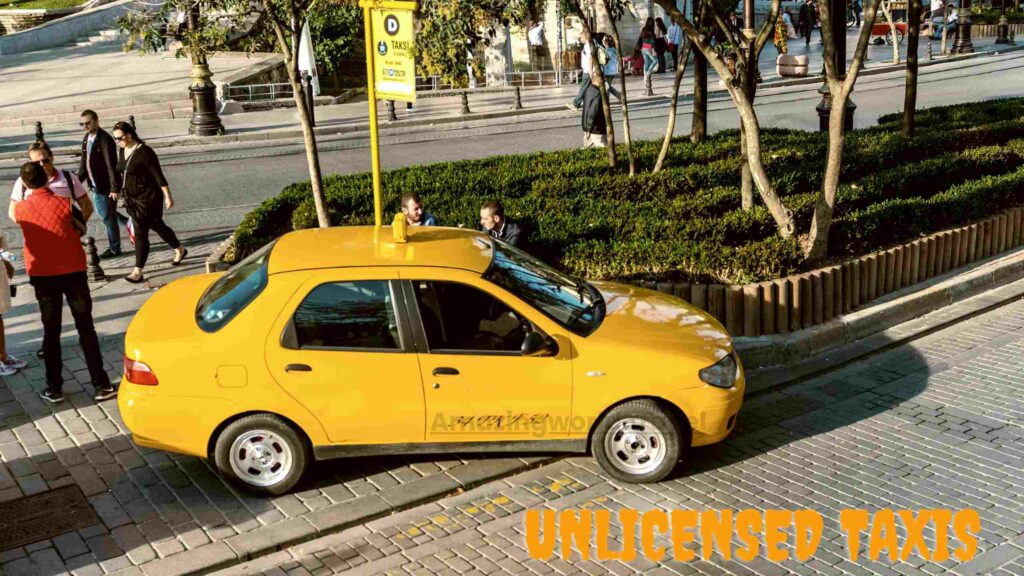
Risks Associated with Unlicensed Taxis
Unlicensed taxis, often referred to as “gypsy cabs” or “pirate taxis,” come with several inherent risks for passengers:
- Lack of Safety Oversight: Unlicensed taxis typically do not undergo regular safety inspections or maintenance checks, which can pose serious risks to passengers’ safety. Vehicles might not be in good condition, increasing the likelihood of accidents or breakdowns during your journey.
- Insurance Issues: Unlicensed drivers may not have the necessary insurance coverage to protect passengers in case of accidents or injuries. This means that you might face difficulties in seeking compensation for damages or medical expenses.
- Overcharging: Unlicensed drivers often operate without adherence to official tariff rates, allowing them to charge passengers arbitrary or inflated fares. This can result in passengers paying significantly more for their journeys than they should.
- No Accountability: When dealing with unlicensed taxis, there is often no regulatory authority overseeing their operations. This means that passengers have limited recourse if they face disputes, overcharging, or unsatisfactory service.
- No Background Checks: Unlike licensed taxi services, unlicensed taxis do not typically require background checks or vetting of drivers. This means you have no assurance of the driver’s reliability, trustworthiness, or criminal history.
How to Identify Legitimate Taxis
To ensure your safety and avoid unlicensed taxis, here are some ways to identify legitimate taxi services:
- Check for Official Markings: Look for official markings and logos on the taxi, such as a taxi company name, registration number, and a taxi meter. Licensed taxis typically display these prominently.
- Ask for Identification: Request identification from the driver, including their taxi license and driver’s license. Legitimate drivers should be willing to provide this information.
- Use Recommended Services: Ask for recommendations from locals, hotels, or official information centers on reputable taxi services in the area.
- Avoid Solicitations: Be cautious of taxi drivers who approach you aggressively at transportation hubs or tourist areas. It’s often safer to approach a designated taxi stand or book a taxi through a reputable app.
- Research Ahead: Research licensed taxi companies and their contact information before your trip. This way, you can call for a taxi from a reputable source rather than accepting rides from unknown drivers.
By following these steps, you can significantly reduce the risk of choosing unlicensed taxis and ensure a safer and more reliable transportation experience during your travels. Always prioritize your safety and comfort when selecting a taxi service.
Scam #8: Fake Airport Taxis
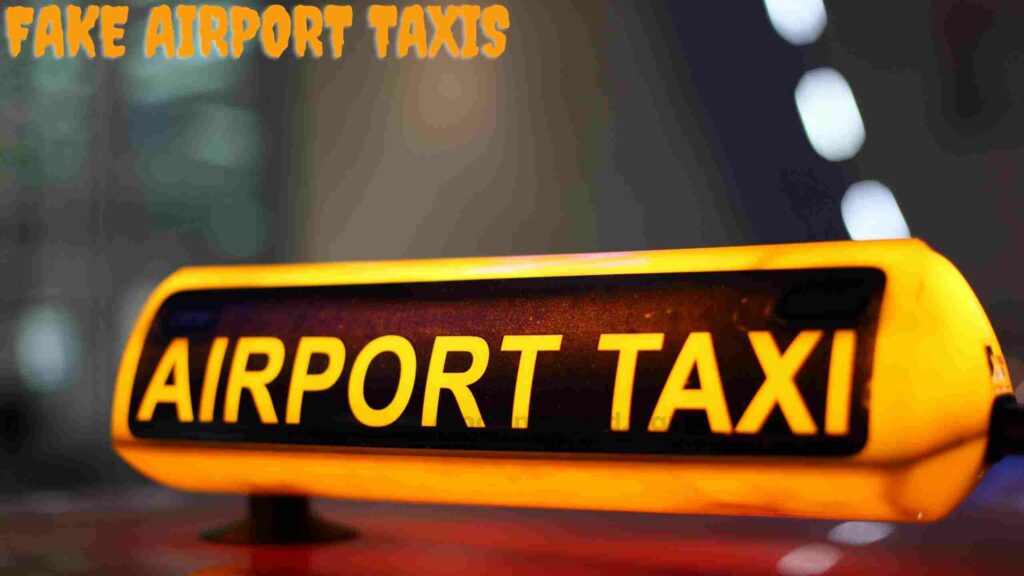
How Scammers Impersonate Airport Taxi Services
Impersonating airport taxi services is a tactic used by scammers to deceive travelers and take advantage of their vulnerability at airports. Here’s how scammers often impersonate airport taxi services:
- Fake Signage: Scammers may use fake signs, logos, or branding that closely resemble those of official airport taxi services. These signs can mislead passengers into thinking they are getting into a legitimate airport taxi.
- Aggressive Approaches: Scammers often position themselves near the airport arrivals area and aggressively approach arriving passengers. They may offer their services, using tactics such as shouting, touting, or making false claims about lower fares.
- Deceptive Uniforms: Some scammers dress in uniforms that mimic those worn by official airport taxi drivers, further creating the illusion of legitimacy.
- Misleading Vehicles: Scammers may use regular private vehicles that are not licensed as taxis to pick up passengers. These vehicles may not meet the safety or regulatory standards required of official airport taxis.
Tips for Using Airport Taxis Safely
To ensure your safety and avoid falling victim to fake airport taxi scams, follow these tips when using airport taxis:
- Use Official Taxi Stands: At the airport, follow signs directing you to official taxi stands or queues. These areas are typically regulated and staffed by legitimate taxi drivers.
- Ignore Solicitations: Avoid taxi drivers who approach you aggressively as you exit the airport terminal. Official airport taxi services do not usually engage in such behavior.
- Check for Identification: Before getting into a taxi, confirm the driver’s identification, including their taxi license and driver’s license. Legitimate drivers should be willing to provide this information.
- Confirm the Fare: Ask the driver for an estimate of the fare to your destination before starting the ride. This can help you identify any significant discrepancies in pricing.
- Use Reputable Taxi Apps: If available, consider using ride-sharing or taxi apps to book your airport taxi. These apps often provide transparent pricing and can be a safer option.
- Research Official Services: Before your trip, research the official airport taxi services at your destination airport. Familiarize yourself with their branding and any contact information you may need.
- Be Cautious of Bargain Offers: If a taxi driver offers a significantly lower fare than others, be cautious. Bargain offers can sometimes be a sign of scammers.
- Stay Vigilant: Remain aware of your surroundings and the details of the vehicle you’re entering. Take note of the driver’s identification and the vehicle’s license number.
By following these safety measures and staying vigilant when using airport taxis, you can minimize the risk of falling victim to fake airport taxi scams and ensure a secure and hassle-free start to your journey.
Scam #9: Unofficial Representatives
Description of Individuals Posing as Taxi Representatives
Scammers often pose as unofficial taxi representatives, especially at transportation hubs, tourist areas, or hotels. These individuals aim to deceive travelers into using unauthorized or overpriced taxi services. Here’s how they typically operate:
- Misleading Attire: Scammers may dress in attire that resembles official taxi company uniforms or badges, creating the illusion that they are legitimate representatives.
- False Claims: They might approach travelers, claiming to be official representatives of a taxi service and offering transportation assistance. They may make false promises about lower fares, special deals, or other perks to entice passengers.
- Misleading Signs: At transportation hubs, scammers may hold signs that display the names of well-known taxi companies, even if they have no affiliation with those companies.
- Aggressive Tactics: Some unofficial representatives may employ aggressive tactics, such as following travelers persistently or pressuring them into using their services.
How to Verify Official Taxi Services
To protect yourself from falling victim to scams involving unofficial taxi representatives, follow these steps to verify the legitimacy of taxi services:
- Use Official Taxi Stands: Whenever possible, use designated taxi stands or queues at transportation hubs or tourist areas. These areas are typically regulated and staffed by legitimate taxi drivers.
- Ignore Unsolicited Offers: Avoid accepting transportation offers from individuals who approach you aggressively or unsolicited. Official taxi services do not typically engage in such behavior.
- Ask for Identification: When approached by someone claiming to represent a taxi service, ask for their identification or official credentials. Official representatives should be able to provide this information.
- Research Ahead: Before your trip, research official taxi services at your destination. Familiarize yourself with their branding and any contact information you may need.
- Use Reputable Taxi Apps: Consider using ride-sharing or taxi apps that provide transparent pricing and allow you to book rides from recognized and licensed drivers.
- Ask Locals or Hotel Staff: Seek recommendations from locals or the staff at your hotel for reputable taxi services in the area. They can provide valuable insights into trustworthy options.
- Be Cautious of Bargain Offers: Be wary of individuals who offer significantly lower fares or special deals, as these can be indicators of scams.
- Stay Vigilant: Always remain aware of your surroundings and exercise caution when interacting with unfamiliar individuals offering transportation services.
By following these precautions and verifying the legitimacy of taxi services, you can reduce the risk of falling victim to scams involving unofficial representatives and ensure a safe and reliable transportation experience during your travels.
Scam #10: No Change

Where Drivers Claim Not to Have Change
The “no change” scam involves taxi drivers claiming not to have change when passengers pay with larger denominations. While not all instances are scams, some drivers use this tactic to overcharge or exploit passengers. Here are common scenarios:
- Intentional Shortage: Some drivers may intentionally claim not to have change, especially when passengers pay with large bills. They count on passengers not wanting to delay the ride and accepting a higher fare.
- Misleading Claims: In some cases, drivers might falsely assert that they don’t have any change at all, even if they do. This can lead passengers to pay more than the actual fare.
- Convenience Fee: A variation of this scam involves drivers suggesting that passengers pay a little extra to round up the fare because they lack change. Passengers might agree to avoid the hassle.
How to Handle This Situation as a Traveler
Handling the “no change” situation as a traveler requires a balance of assertiveness and diplomacy to ensure you’re not overcharged. Here’s how to deal with it:
- Ask for Change Ahead of Time: Before the ride starts, check if the driver can provide change for the denomination you plan to use. This can prevent the issue from arising later.
- Carry Small Denominations: Whenever possible, carry small bills or coins with you to pay the exact fare. Having the correct change can eliminate the driver’s excuse for not having change.
- Insist on Change: If the driver claims not to have change, politely insist on receiving your change. Express that you’d like to pay the exact fare.
- Use a Taxi App or Prepaid Service: Consider using a taxi app or prepaid taxi service that calculates the fare digitally and eliminates the need for cash transactions. This can also provide transparency and convenience.
- Be Prepared to Wait: If the driver genuinely doesn’t have change and you’re paying with a large bill, be prepared to wait until they can obtain the necessary change. In some cases, they may visit a nearby store or gas station.
- Request a Receipt: If you believe you’ve been overcharged due to a lack of change, request a receipt for the fare. You can use this as evidence to report any issues later.
- Report Suspected Scams: If you suspect the driver is intentionally overcharging you by claiming not to have changed, consider reporting the incident to local authorities or taxi regulators.
Remember that not all cases of drivers claiming not to have changed are scams. Sometimes, it may genuinely be a matter of the driver not having small bills on hand. However, it’s essential to be aware of the possibility and handle the situation with vigilance to ensure a fair and transparent transaction.
Conclusion
In your travels, taxi services can be a convenient way to get around and explore new destinations. However, it’s essential to remain vigilant and informed about common taxi scams that can potentially ruin your experience and dent your budget. By staying aware and taking precautions, you can significantly reduce the chances of falling victim to these scams.
Remember, knowledge is your best defense against taxi scams. Research your destination before you travel to familiarize yourself with the local transportation options, typical fares, and reputable taxi services.
How much did you like Our Detailed Taxi scams in the USA and Europe: 12 tips to avoid them? Review Also, please share these Blogs with your friends on social media.
Recommended

Meet David Hoper, a passionate travel Blog writer with 7+ years of experience in travel content. Through his exemplary storytelling and engaging narratives, he shares his experiences and brings destinations to life. With a keen eye for detail and a love for exploration, he has cultivated a diverse portfolio of travel blogs that inspire and inform readers worldwide.
